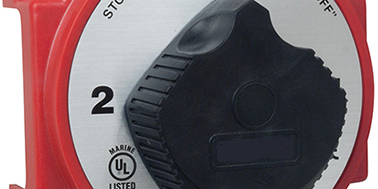If you have multiple batteries that you charge with your boat engine, you surely have a battery selector switch. It may be useful to review a few installation, operational and maintenance factors connected with the use of these switches.
- Make sure the amperage rating is correct for your electrical system.
- Make sure you provide adequate strain relief for your heavy gauge battery cables.
- Take into account length of run and load in selecting battery cables if you are installing a remote second battery.
- Apply a liquid electrical coating to the terminal connections.
- Do not exceed the switch’s torque specification for the terminal connections, or over-tighten the mounting screws.
- Consider the lifetime of the switch to be three to five years, especially in a salt water environment.
- Never switch to OFF while the engine is running (alternator is charging).
- Never switch to BOTH (two battery system) when the boat fails to start with the starting battery.
- As a maintenance item, measure the voltage to the switch from each battery and also the voltage at the positive bus bar to make sure they are equal.
- Periodically operate the switch rapidly with all loads disconnected to remove oxidation from the contacts.
- Do not open the switch body in an attempt to service the contacts if the switch is installed an an enclosed area—you might compromise the ignition-protected design of the switch and introduce an explosion hazard.
Features to look for in a switch:
- Alternator field disconnect; protects circuits from catastrophic voltage surges when the switch is moved from 1 to 2 or OFF while the alternator is charging.
- Make-before-break switch operation to protect alternator diodes.
- Fiber-reinforced polymer body construction to withstand stresses from mounting screws and battery cable strain.
What can happen
The above factors are important in avoiding a failure that can leave you with partial or no electrical power while under way, or the inability to start your engines. See if you can match the following avoidable situations with the recommendations above:
- Melting of the switch body, with loss of all circuits.
- Mechanical disintegration of the switch, with loss of all circuits.
- Voltage spike to all circuits with loss of one or more of them, including GPS and communications.
- One battery completely draining the other, with inability to start the engine.
As you can see, neglecting to understand and maintain this vital component can leave you in a serious situation. Be sure that you have the necessary wrenches, screwdrivers, electrical tape, nuts and bolts aboard to enable you to safely bypass a failed switch so that you can start your engine safely and power critical circuits. Also, have aboard a current wiring diagram and an emergency diagram to help you safely bypass the switch in an emergency.







